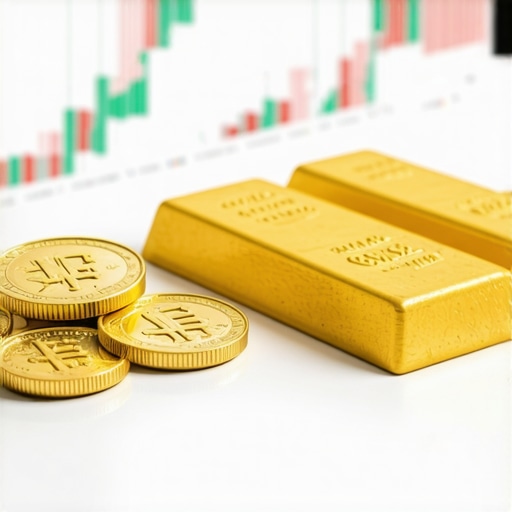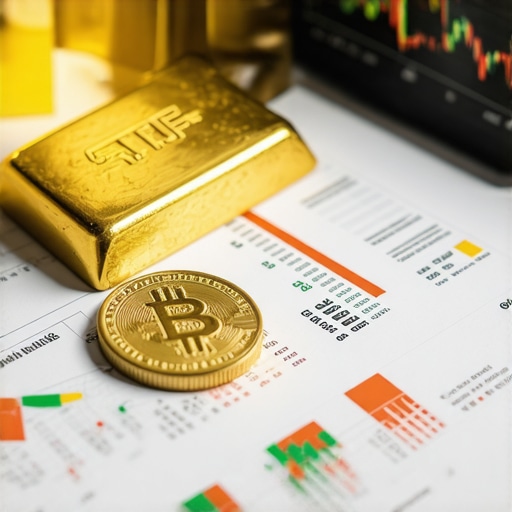Understanding Gold Futures: A Beginner’s Perspective
The world of gold investments can seem daunting, especially when it comes to the intricate details of futures trading. This essential guide to gold futures aims to demystify the concept, making it accessible for beginners. Gold futures contracts are agreements to buy or sell a specific amount of gold at a predetermined price on a future date. This type of investment allows traders to speculate on the future price of gold without needing to own the physical metal.
What Are Gold Futures?
Gold futures are standardized contracts traded on exchanges, such as the New York Mercantile Exchange (NYMEX). They provide a way for investors to hedge against price fluctuations or to profit from anticipated movements in gold prices. For instance, if an investor believes gold prices will rise, they might purchase futures contracts to lock in current prices. Conversely, if they anticipate a decline, they may sell contracts to avoid losses.
One of the main advantages of trading gold futures is leverage. This means traders can control a larger position than their initial investment by only putting down a fraction of the contract’s value as margin. However, this also increases the risk, as losses can exceed the initial investment.
Why Consider Gold Futures for Investment?
Investing in gold futures can be attractive for several reasons:
- Diversification: Adding gold futures to an investment portfolio can provide a hedge against economic uncertainty and inflation.
- Liquidity: Gold futures are highly liquid, making it easier to enter and exit positions compared to physical gold investments.
- Potential for High Returns: The leverage offered in futures trading can result in significant profits if the market moves in the investor’s favor.
Challenges Faced by Beginners
Despite the potential benefits, beginner investors must be aware of the challenges associated with trading gold futures:
- Market Volatility: Gold prices can be influenced by various factors, including geopolitical events, economic data, and changes in currency values. This volatility can lead to rapid gains or losses.
- Complexity: Futures trading involves a steep learning curve, requiring an understanding of market dynamics, technical analysis, and risk management strategies.
For those who are new to investing, starting with physical gold or gold ETFs might be more suitable. These options can provide exposure to gold prices without the complexities of futures contracts. For example, exploring gold demand trends can help investors understand the market better.
Is Gold Futures Right for You?
Determining whether gold futures are suitable for your investment goals involves evaluating your risk tolerance, market knowledge, and investment strategy. Beginners should consider starting with educational resources, such as understanding the basics of investing in gold stocks and 2025 gold price forecasts. These insights can provide valuable context and help guide your investment decisions.
In conclusion, gold futures present a unique opportunity for investors looking to diversify their portfolios. However, beginners should approach this market with caution, ensuring they are well-informed and prepared for the risks involved. As you delve deeper into the world of gold investments, consider exploring additional topics such as understanding gold price fluctuations and exploring future trends for 2025.
Exploring the Mechanics of Gold Futures Trading
To truly understand how to navigate the world of gold futures, it’s crucial to delve into the specific mechanics involved in trading these contracts. Gold futures trading operates on the principle of speculation and hedging, allowing investors to engage with the market without the need for physical gold ownership.
How Gold Futures Work
When you enter a gold futures contract, you agree to buy (or sell) a specified amount of gold at a predetermined price on a future date. This means that if you believe the price of gold will increase, you can purchase a futures contract now to lock in that price, potentially standing to gain significant profits should your prediction prove accurate. On the other hand, if you foresee a decline in gold prices, you might opt to sell futures contracts to minimize potential losses.
Understanding the trends in the gold market is essential for making informed decisions in this arena. Market dynamics can shift due to various factors, including economic reports, changes in interest rates, and geopolitical tensions. For beginners, becoming familiar with these influences can enhance their ability to react to market fluctuations effectively.
The Importance of Risk Management
Risk management is a fundamental aspect of trading gold futures. Given the potential for high volatility in gold prices, it’s vital for traders to implement strategies that protect their investments. Some common risk management practices include:
- Setting Stop-Loss Orders: These orders automatically sell a futures contract if the price reaches a predetermined level, helping to limit losses.
- Diversifying Your Portfolio: Incorporating various asset classes alongside gold can mitigate risk.
- Using Position Sizing: This involves determining how much of your capital to risk on a single trade, which can help manage overall exposure.
For beginners, it may be beneficial to start with physical gold investments or gold ETFs, which provide more straightforward exposure to the gold market without the complexities of futures contracts.
Market Analysis Techniques for Gold Futures
Understanding how to analyze the market is crucial for success in gold futures trading. Traders often use a combination of technical and fundamental analysis to gauge market conditions:
- Technical Analysis: This involves studying price charts and patterns to predict future price movements. Technical indicators, such as moving averages and Relative Strength Index (RSI), can provide insights into market trends.
- Fundamental Analysis: This type of analysis assesses external factors, such as economic indicators and geopolitical events, that may influence gold prices. For instance, a rise in inflation often leads investors to flock to gold as a safe haven, driving prices up.
To enhance your understanding of these market dynamics, consider reviewing resources like gold price forecasts and insights from industry experts. These materials can provide a foundation for making informed trading decisions.
Should You Trade Gold Futures?
Ultimately, the decision to trade gold futures should be based on individual investment goals, risk tolerance, and market knowledge. While the potential returns can be alluring, the risks involved are significant. Beginners should weigh their options carefully and consider engaging with simpler forms of gold investment, such as gold ETFs or diversified portfolios, before venturing into futures trading. Understanding the fundamentals of gold trading is critical in navigating this dynamic market successfully.
Advanced Strategies for Successful Gold Futures Trading
For those who have grasped the basics of gold futures trading and are looking to enhance their approach, implementing advanced strategies can significantly improve your chances of success. These strategies involve a deeper understanding of market dynamics and risk management techniques.
Utilizing Hedging Techniques
One of the most effective methods to mitigate risk in gold futures trading is through hedging. Hedging involves taking an offsetting position in the market to protect against potential losses. For instance, if you hold a long position in gold futures and anticipate a price drop, you could sell a futures contract to counteract the risk. This technique allows you to secure profits or minimize losses regardless of market movements.
Additionally, hedging can be particularly beneficial during periods of high volatility, which can be common in the gold market due to geopolitical tensions or major economic shifts. Understanding how to implement diversification strategies can further enhance your overall risk management.
Incorporating Technical Analysis for Timing
Technical analysis is a vital tool for traders seeking to optimize their entry and exit points. By analyzing historical price data and identifying patterns, traders can make informed decisions about when to buy or sell gold futures. Common technical indicators include:
- Moving Averages: These help smooth out price action and identify trends over specific periods.
- Relative Strength Index (RSI): This indicator measures the speed and change of price movements to identify overbought or oversold conditions.
- Fibonacci Retracement Levels: These levels can indicate potential reversal points based on historical price movements.
Combining technical analysis with fundamental insights, such as those found in gold price forecasts, can provide a comprehensive view of the market and improve decision-making.
Understanding Market Sentiment
Another critical aspect of successful trading is gauging market sentiment. Investor behavior can greatly influence gold prices, often driven by fear, greed, and news events. Monitoring sentiment indicators, such as the Commitment of Traders (COT) report, can provide insights into how different market participants are positioning themselves in the gold market.
For instance, a significant shift in positioning by large traders may signal an impending price movement. Engaging with resources that analyze gold market trends can help you stay informed and respond proactively to changes in market sentiment.
Leveraging Options for Flexibility
For advanced traders, incorporating options on gold futures can offer additional flexibility in your trading strategy. Options provide the right, but not the obligation, to buy or sell a futures contract at a predetermined price within a specific time frame. This can be particularly advantageous for managing risk while maintaining the potential for profit.
Options strategies, such as covered calls or protective puts, can enhance your overall strategy by providing income opportunities or limiting losses. Understanding how to effectively utilize these strategies can make a considerable difference in your trading outcomes.
Continuous Education and Adaptation
Lastly, remaining adaptable and committed to continuous education is essential in the ever-evolving world of gold futures. Markets are influenced by a myriad of factors, and staying informed about global events, economic indicators, and emerging trends is crucial. Engaging with resources that provide insights into gold price forecasts and predictions for 2025 can help you anticipate changes and adjust your strategies accordingly. By integrating these advanced techniques and insights into your trading, you can position yourself for greater success in the dynamic gold futures market.
Understanding Gold Futures Trading Risks and Rewards
As you navigate the complexities of gold futures trading, it is essential to grasp both the risks and rewards associated with this investment strategy. Understanding these elements can help you make informed decisions that align with your financial goals.
Evaluating Potential Rewards
The allure of gold futures lies primarily in their potential for significant returns. With the right market analysis, investors can capitalize on price fluctuations and leverage their positions for greater gains. The ability to trade on margin further enhances the potential for profit, allowing traders to control larger positions with a smaller initial investment. However, this leverage also comes with heightened risks.
Identifying Risks in Gold Futures Trading
Despite the attractive rewards, gold futures trading is not without its challenges. Market volatility can lead to rapid changes in prices, resulting in substantial losses if positions are not managed correctly. Traders must be vigilant and prepared for unexpected shifts in the market caused by geopolitical events or economic reports.
To mitigate these risks, it’s advisable to implement a robust risk management strategy. This might include setting stop-loss orders and diversifying your portfolio to spread risk across different assets.
Key Indicators for Successful Gold Futures Trading
Successful trading in gold futures relies heavily on understanding various market indicators. By monitoring these indicators, traders can better predict price movements and make informed trading decisions.
Technical Indicators to Watch
Technical analysis plays a crucial role in gold futures trading. Key indicators to monitor include:
- Moving Averages: These indicators help identify trends and potential reversal points in gold prices, making it easier to decide when to enter or exit trades.
- Bollinger Bands: These bands indicate volatility and potential price breakouts, providing insight into market conditions.
- Fibonacci Retracement Levels: Traders often use these levels to identify potential support and resistance areas, which can inform their trading strategies.
Fundamental Factors Influencing Gold Prices
In addition to technical analysis, understanding fundamental factors is crucial. Economic indicators such as inflation rates, employment data, and changes in interest rates can significantly impact gold prices. For instance, rising inflation often drives investors toward gold as a hedge, leading to increased demand and higher prices.
Staying informed about geopolitical events is equally important, as these can lead to sudden price swings. For example, tensions in major gold-producing countries can affect supply and consequently influence global prices.
Developing a Strong Trading Plan
A well-defined trading plan is essential for success in gold futures trading. This plan should outline your investment goals, risk tolerance, and specific strategies you intend to employ.
Defining Your Investment Goals
Before entering the market, clarify your investment objectives. Are you looking for short-term profits or long-term wealth accumulation? Your goals will influence the strategies you choose. For instance, long-term investors may focus on fundamental analysis, while short-term traders might rely on technical indicators.
Implementing Your Trading Strategy
Once you have defined your goals, implement a comprehensive trading strategy. This might include setting specific entry and exit points based on your analysis. Additionally, regularly reviewing and adjusting your strategy based on market conditions can help you stay ahead in the dynamic world of gold futures.
Ultimately, continuous learning and adaptation are key to navigating the complexities of gold futures trading successfully. Engaging with resources that provide insights into future gold price forecasts can enhance your trading decisions and keep you informed about market trends.
Frequently Asked Questions (FAQ) About Gold Futures
What is gold futures trading?
Gold futures trading involves contracts that obligate the buyer to purchase, and the seller to sell, a specific quantity of gold at a predetermined price on a future date. This allows investors to speculate on the price movements of gold without needing to own physical gold.
How can I start trading gold futures?
To start trading gold futures, you’ll need to open an account with a brokerage that offers futures trading. After funding your account, you can begin analyzing the market and placing trades based on your investment strategy.
What are the risks associated with gold futures trading?
Gold futures trading carries several risks, including market volatility, the potential for significant losses due to leverage, and the complexity of market dynamics. Traders must implement effective risk management strategies to mitigate these risks.
Is gold futures trading suitable for beginners?
While it is possible for beginners to trade gold futures, it is generally recommended to gain a solid understanding of the market and trading strategies first. Beginners might consider starting with simpler investment options like gold ETFs or physical gold.
How do I analyze the gold market for trading?
Market analysis for gold trading typically involves both technical and fundamental analysis. Technical analysis focuses on price charts and indicators, while fundamental analysis considers economic indicators, geopolitical events, and market sentiment.
What is the role of leverage in gold futures trading?
Leverage in gold futures trading allows traders to control a larger position than their initial investment. While this can amplify profits, it also increases the risk of substantial losses, as losses can exceed the initial investment.
What are some common strategies for trading gold futures?
Common strategies for trading gold futures include hedging to minimize risk, using technical analysis for timing trades, and monitoring market sentiment to gauge investor behavior. Developing a comprehensive trading plan is also crucial for success.
How can I stay updated on gold market trends?
Staying updated on gold market trends involves regularly reviewing financial news, analysis from trusted sources, and economic reports that impact gold prices. Engaging with expert insights and forecasts can also enhance your understanding.
Can I trade gold futures on my own, or should I seek professional advice?
While it is possible to trade gold futures independently, seeking professional advice or utilizing educational resources can help beginners navigate the complexities of the market more effectively.
Authority Resources for Gold Futures Trading
To enhance your knowledge of gold futures trading, consider exploring the following trusted resources:
- CME Group – Gold Futures: The official site of the CME Group provides comprehensive information on gold futures contracts, trading strategies, and market data.
- Kitco Metals: A leading source of precious metals market news and analysis, offering insights into gold price trends and investment advice.
- Investopedia – Gold Futures: A reliable educational platform that explains gold futures trading, including strategies and risks involved.
- Bloomberg – Commodities: Provides up-to-date news and analysis related to commodities, including gold, helping traders stay informed about market movements.
- World Gold Council: Offers insights and research on gold demand, market trends, and investment opportunities.
Conclusion
Gold futures trading presents an exciting opportunity for investors seeking to diversify their portfolios and capitalize on market movements. By understanding the intricacies of gold futures, including the risks, rewards, and effective trading strategies, traders can make informed decisions that align with their financial goals. Whether you are a beginner or an experienced trader, staying educated and adaptable is key to navigating the ever-evolving world of gold investments. As you explore this dynamic market, refer to trusted resources and continuously seek insights to enhance your trading success.









